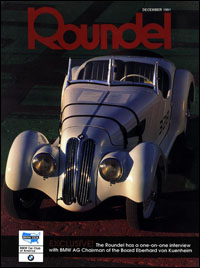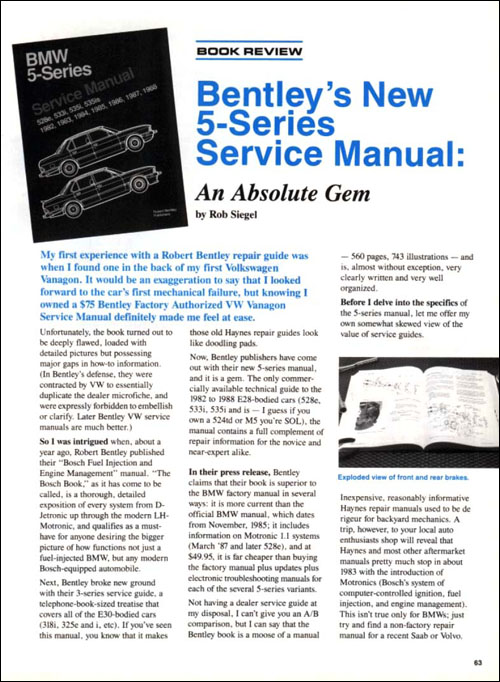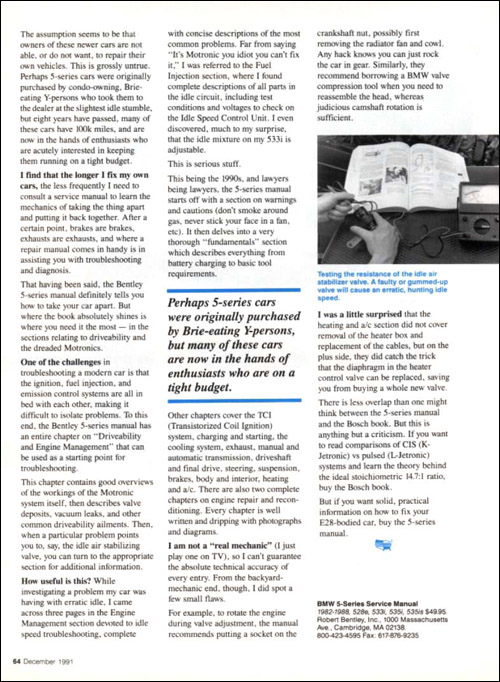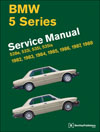|
BMW 5 Series (E28)
Service Manual: 1982, 1983, 1984, 1985, 1986, 1987, 1988
Price: $124.95
|

Roundel - December 1991
Review of BMW 5 Series Service Manual: 1982?1988 from Roundel, December 1991
BENTLEY'S NEW 5-SERIES SERVICE MANUAL: An Absolute Gem
"My first experience with a Robert Bentley repair guide was when I found one in the back of my first Volkswagen Vanagon. It would be an exaggeration to say that I looked forward to the car's first mechanical failure, but knowing I owned a $75 Bentley Factory Authorized VW Vanagon Service Manual definitely made me feel at ease.Unfortunately, the book turned out to be deeply flawed, loaded with detailed pictures but possessing major gaps in how-to information. (In Bentley's defense, they were contracted by VW to essentially duplicate the dealer microfiche, and were expressly forbidden to embellish or clarify. Later Bentley VW service manuals are much better.)
So I was intrigued when, about a year ago, Robert Bentley published their "Bosch Fuel Injection and Engine Management" manual. "The Bosch Book," as it has come to be called, is a thorough, detailed exposition of every system from D-Jetronic up through the modern LH-Motronic, and qualifies as a must-have for anyone desiring the bigger picture of how functions not just a fuel-injected BMW, but any modern Bosch-equipped automobile.
Next, Bentley broke new ground with their 3-series service guide, a telephone-book-sized treatise that covers all of the E30-bodied cars (318i, 325e and i, etc). If you've seen this manual, you know that it makes those old Haynes repair guides look like doodling pads.
Now, Bentley publishers have come out with their new 5-series manual, and it is a gem. The only commercially available technical guide to the 1982 to 1988 E28-bodied cars (528e, 533i, 535i and is - I guess if you own a 524td or MS you're SOL), the manual contains a full complement of repair information for the novice and near-expert alike.
In their press release, Bentley claims that their book is superior to the BMW factory manual in several ways: it is more current than the official BMW manual, which dates from November, 1985; it includes information on Motronic 1.1 systems (March '87 and later 528e), and at $49.95, it is far cheaper than buying the factory manual plus updates plus electronic troubleshooting manuals for each of the several 5-series variants.
Not having a dealer service guide at my disposal, I can't give you an A/B comparison, but I can say that the Bentley book is a moose of a manual - 560 pages, 743 illustrations - and is, almost without exception, very clearly written and very well organized.
Before I delve into the specifics of the 5-series manual, let me offer my own somewhat skewed view of the value of service guides.
Inexpensive, reasonably informative Haynes repair manuals used to be de rigeur for backyard mechanics. A trip, however, to your local auto enthusiasts shop will reveal that Haynes and most other aftermarket manuals pretty much stop in about 1983 with the introduction of Motronics (Bosch's system of computer-controlled ignition, fuel injection, and engine management). This isn't true only for BMWs; just try and find a non-factory repair manual for a recent Saab or Volvo.
The assumption seems to be that owners of these newer cars are not able, or do not want, to repair their own vehicles. This is grossly untrue. Perhaps 5-series cars were originally purchased by condo-owning, Brie-eating Y-persons who took them to the dealer at the slightest idle stumble, but eight years have passed, many of these cars have 100k miles, and are now in the hands of enthusiasts who are acutely interested in keeping them running on a tight budget.
I find that the longer I fix my own cars, the less frequently I need to consult a service manual to learn the mechanics of taking the thing apart and putting it back together. After a certain point, brakes are brakes, exhausts are exhausts, and where a repair manual comes in handy is in assisting you with troubleshooting and diagnosis.
That having been said, the Bentley 5-series manual definitely tells you how to take your car apart. But where the book absolutely shines is where you need it the most - in the sections relating to driveability and the dreaded Motronics.
One of the challenges in troubleshooting a modern car is that the ignition, fuel injection, and emission control systems are all in bed with each other, making it difficult to isolate problems. To this end, the Bentley 5-series manual has an entire chapter on "Driveability and Engine Management" that can be used as a starting point for troubleshooting.
This chapter contains good overviews of the workings of the Motronic system itself, then describes valve deposits, vacuum leaks, and other common driveability ailments. Then, when a particular problem points you to, say, the idle air stabilizing valve, you can turn to the appropriate section for additional information.
How useful is this? While investigating a problem my car was having with erratic idle, I came across three pages in the Engine Management section devoted to idle speed troubleshooting, complete with concise descriptions of the most common problems. Far from saying "It's Motronic you idiot you can't fix it," I was referred to the Fuel Injection section, where I found complete descriptions of all parts in the idle circuit, including test conditions and voltages to check on the Idle Speed Control Unit. I even discovered, much to my surprise, that the idle mixture on my 533i is adjustable.
This is serious stuff.
This being the 1990s, and lawyers being lawyers, the 5-series manual starts off with a section on warnings and cautions (don't smoke around gas, never stick your face in a fan, etc). It then delves into a very thorough "fundamentals" section which describes everything from battery charging to basic tool requirements.
Perhaps 5-series cars were originally purchased by Brie-eating Y-persons, but many of these cars are now in the hands of enthusiasts who are on a tight budget.
Other chapters cover the TCI (Transistorized Coil Ignition) system, charging and starting, the cooling system, exhaust, manual and automatic transmission, driveshaft and final drive, steering, suspension, brakes, body and interior, heating and a/c. There are also two complete chapters on engine repair and reconditioning. Every chapter is well written and dripping with photographs and diagrams.
I am not a "real mechanic" (I just play one on TV), so I can't guarantee the absolute technical accuracy of every entry. From the backyard-mechanic end, though, I did spot a few small flaws.
For example, to rotate the engine during valve adjustment, the manual recommends putting a socket on the crankshaft nut, possibly first removing the radiator fan and cowl. Any hack knows you can just rock the car in gear. Similarly, they recommend borrowing a BMW valve compression tool when you need to reassemble the head, whereas judicious camshaft rotation is sufficient.
I was a little surprised that the heating and a/c section did not cover removal of the heater box and replacement of the cables, but on the plus side, they did catch the trick that the diaphragm in the heater control valve can be replaced, saving you from buying a whole new valve.
There is less overlap than one might think between the 5-series manual and the Bosch book. But this is anything but a criticism. If you want to read comparisons of CIS (K-Jetronic) vs pulsed (L-Jetronic) systems and learn the theory behind the ideal stoichiometric 14.7:1 ratio, buy the Bosch book.
But if you want solid, practical information on how to fix your E28-bodied car, buy the 5-series manual."
?Rob Siegel

Roundel, December 1991, p63

Roundel, December 1991, p64
![[B] Bentley Publishers](http://assets1.bentleypublishers.com/images/bentley-logos/bp-banner-234x60-bookblue.jpg)
